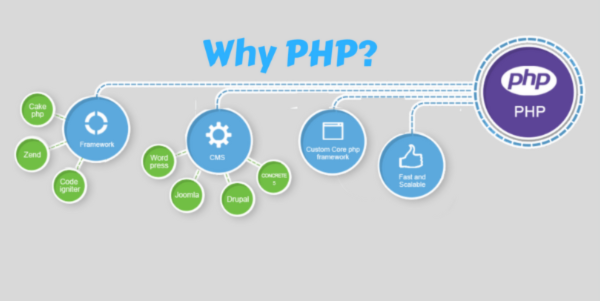
What is a CMS Framework PHP? Before getting into too many details, let us learn through simpler blocks of topics.
First, what is CMS?
A Content Management System (CMS) helps you publish your web content, such as a website or a webshop.
It is an application with two purposes: content management application and content delivery.
It has valuable features to do these functions, saving us time and energy from building everything from scratch.
Without it, you would need to create your admin panel, HTML, CSS, JavaScript, a database of your own, interface for login and updating information. CSS is the style element, and JS determines how to move, forming the browser reading HTML. A contact management system abstracts away the code information into a GUI interface, where the user can input information that can dynamically change everything.
Interestingly, content management systems such as Word Press come with plugins that help with multiple-use purposes, such as adding social features, catching leads, building membership areas, changing themes, etc. These are open source and are available to all. Such content management systems are always in the news, such as Tumbler, which gets lots of traffic, and Stacey, which is a lightweight alternative and portable since it doesn’t need a database.
What is a framework?
Much like the literal meaning, a framework is a set of rules to follow while building a website. You can also not follow how to manually build a website with your own hands using core, which is a light weighted code. The CORE’s primary purpose is custom development. But, the framework keeps the code clean. A framework is a set of libraries that provide database access template engines to build a web application. A framework builds content management systems, for example, Code igniter and Cake PHP.
A CMS extension is made possible through website plugins or third-party integrations. You get them for free or buy them at places like the plugins store of Word Press Plugins store, Template Monster Plugins, Hello Retail, and such.
Similarly, Frameworks can also avail extensions using core features like plugins of CMS.

Check out: CMS vs Framework
What is PHP CMS Framework
PHP is a programming language to build Content Management Systems using a framework.
The term PHP stands for Hypertext Preprocessor. PHP is a scripting language aiding web development. It is open-source, and files are available online with the extension “.php.” These PHP CMS Frameworks reduce the regular work of developers.
Websites like Facebook and Yahoo stand as famous examples built using PHP.
· PHP code is executed server-wide.
· Common content management systems can use PHP to control user access.
· You can integrate it with all databases such as Oracle, Microsoft SQL Server, MySQL, PostgreSQL, Informix, and Sybase.
· PHP works with all operating systems like Windows, Linux, and macOS.
· It supports all protocols like HTTP Basic, Digest, IMAP, and FTP.
· PHP files are compatible with other scripting languages like CSS and JavaScript.
· Although it is Open Source, the client or browser cannot access the actual PHP codes of the PHP file. Open Source
· It has great Library Support and high Database Connectivity

PHP Syntax:
<?PHP
PHP code goes here
?>
Code Example:
· HTML
<html>
<head>
<title>PHP Example</title>
</head>
<body>
<?PHP echo “Hi, I am a PHP code”;?>
</body>
</html>
Output:
Hi, I am a PHP code
Why should we use PHP?
PHP is server-side scripting of the backend of a website. PHP CMS Frameworks can perform operations such as receiving data, generating page content, working with databases, sending and receiving cookies, sending emails, and creating sessions. In addition, PHP ensures data encryptions using hash functions to help with data security and is reliable.
What is the purpose of using CMS PHP Framework?

Image Source: fastwebhost.com
Customization
With a PHP CMS Framework, you can create a new type of content management system. However, the most significant purpose of CMS PHP Framework is the customization you can achieve. You can create unique and varied features because frameworks don’t just do it. Instead, a framework provides basic features such as creating a login system or leveraging user privileges.
Frameworks are customizable in immense amounts, but CMS’ has limitations. This limitation is because you need help redefining a CMS’s core functionality, and updating your CMS system takes a lot of work.
Security
Since CMS is open source, it poses a security threat, especially when conducting online business. Security should be one of your biggest concerns when building a website or an application, especially for an online business.
Data encryption
Websites built using frameworks use custom code such as CMS Framework PHP, which makes it harder for hackers to find security flaws. Moreover, frameworks contain built-in functions such as SQL injection or Cross Site Scripting. These functions protect by facilitating encryption.
Flexibility
A CMS might need help to include unique features or integrate with third-party applications such as a CRM (customer relationship management) tool, like Salesforce. But as we said earlier, frameworks have flexibility as the main advantage of using plugin libraries.
Updates
Although most Content Management Systems update every month, the need for using frameworks to build is that there is no need for constant upgrades. Frameworks still maintain the functionality of websites without the constant need for upgrades.
Time management
Frameworks can save time when working on large web development projects. However, more extensive applications can have unique requirements involving large feature sets. Hence they need custom programming and protection of custom-coded solutions, which only frameworks provide.
Some of the CMS PHP Frameworks are:

Image Source: netconnectdigital.com
Laravel: Laravel is a PHP web application framework developed in 2011. It is known for its elegant syntax and vast ecosystem.
Code Igniter: Code Igniter is the PHP framework known for its architecture and suiting for beginners. It aids in dividing an application into three primary parts Model, View, and Controller. Furthermore, it is fuss-free to install and has a small footprint. Therefore, it is ideal for building lightweight applications.
Phalcon: Phalcon is readily available through PHP classes and interfaces provided by the Phalcon namespace. The full-stack PHP framework is in C- and C ++, but one doesn’t need to know C. It also uses fewer resources than frameworks, thus consuming less memory and handling more HTTP requests.
Symfony: Symfony is a classic PHP framework. It is generally used in large-scale enterprise projects as they have purposeful libraries and components.


